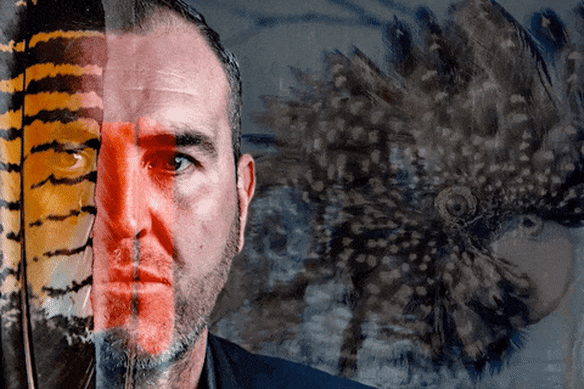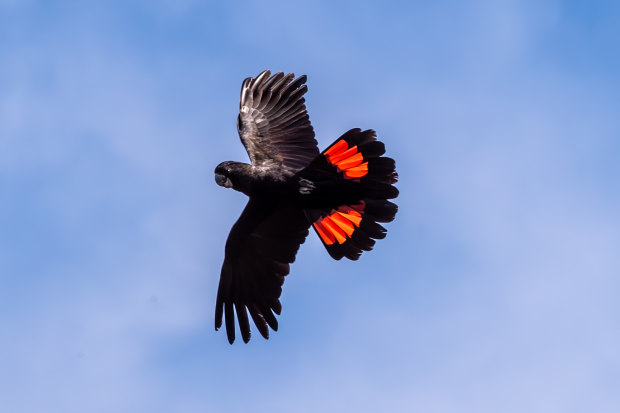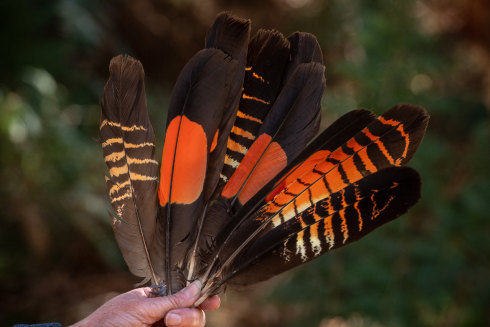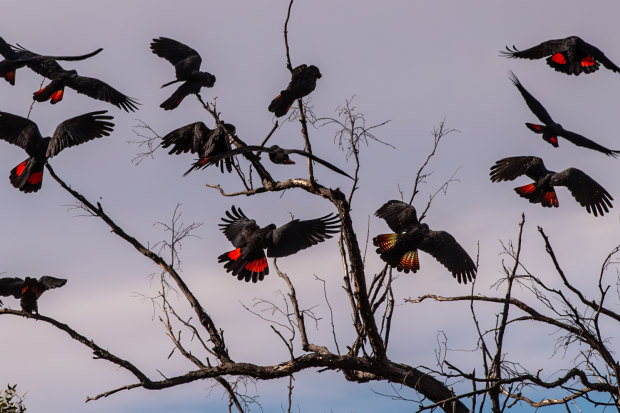Travis turns heads when he wears this feather. But there’s a grim prediction behind it
Age photographer Justin McManus joined the annual count of the red-tailed black cockatoo, an endangered bird that has enormous cultural significance for First Nations people of the region.
By Justin McManus

Travis Lovett and tail feathers of his totem, the red-tailed black cockatoo.Credit: Justin McManus/Tom McKendrick
When Kerrupmara, Gunditjmara and Boandik man Travis Lovett wears the tail feathers of his traditional totem – the south-eastern red-tailed black cockatoo – people stop him in the street to ask about them.
Lovett, who is a commissioner with the Yoorrook Justice Commission, also wears the bright red and orange-banded feathers when he is officiating at the truth-telling inquiry, including when Victorian Premier Jacinta Allan fronted the commission.
The red-tailed black cockatoo has enormous cultural significance for Aboriginal people in the areas surrounding the bird’s natural habitat, in south-west Victoria and south-east South Australia.
“A lot of people don’t know what the feathers that I’m actually wearing are,” says Lovett. “That’s what starts the conversation, whether I’m in a lift or walking down the street and people say ‘What’s that?’, and then I share what it means to us.
“The red-tail has our spirit, it has our ancestors, and it’s connected to our songlines, our lore. The red-tail dictates our clan marriage protocols,” Lovett says. “When we’re on Country, we are able to connect with them; we mimic some of those behaviours through our language, culture and also our dance.”
Lovett is among many who are deeply concerned about the future of the subspecies, whose numbers have dwindled over decades. “Our ancestors, our elders and people have fought too hard to let the red-tail become extinct.”
The south-eastern red-tailed black cockatoo is one of five subspecies of the bird across Australia, and the most endangered, with between 1000 and 1500 remaining in the wild.
Loss of habitat, especially tree hollows for nesting and food supply, along with bushfires, predators and illegal birding, are among its greatest challenges.
On a foggy Saturday morning in May, The Age joins the annual red-tail black cockatoo count, teaming up with Richard Hill, Evelyn Nicholson and a troupe of volunteers before they set out on the rolling red gum country outside Casterton in search of the cocky.

A red-tailed black cockatoo in flight.Credit: Justin McManus
Hill is a member of the south-eastern Red-tailed Black Cockatoo Recovery Project and a veteran of 30 years’ monitoring and helping to protect the red-tail. He’s less than optimistic that we will spot a red-tail, let alone manage to photograph one.
Nicholson’s form on the cocky count is also less than encouraging. She has been doing it for 18 years, but in all that time she has never seen a red-tailed black cockatoo during the annual survey.
“It’s because they are so mobile and the likelihood of surveying an area that currently has cockatoos is not that high,” she says.
Birdlife Australia project coordinator and count organiser Bron Perryman briefs the band of volunteers before they set out.
“We do an annual count each year, and it gives us an idea of the minimum number of birds on that day,” says Perryman. “But more importantly, we do the count to find the location of large flocks, and from there we go out and do flock counts.
“We do a count of the male birds” – with the distinctive bright red tails – “and the barred birds; the barred birds are females and juvenile, which have banded-orange tails. But the flock counts give us our best indication of breeding success from the previous season.
“Unfortunately, over the last 20 years that we’ve been counting, the trend is that the females and juveniles are declining, so we feel there is a declining population,” she says.
Perryman says the birds are their own worst enemy. “They are notoriously fussy eaters. They only feed on two types of stringybark [seed], and seasonally on buloke seed.”
And those specific food sources are becoming scarcer as more habitat is cleared across the red-tail’s range, which covers parts of the Wimmera, Mallee and western Victoria, as well as south-eastern South Australia.
“We’ve taken about 50 per cent of their stringybarks and 97 per cent of their buloke habitat across their range,” says Perryman.
“That loss of habitat has seriously reduced the red-tail population. They are endangered, and there are only around 1200 -1300 birds left in the wild.”
To begin the count, volunteers are assigned an area to search, marked by a grid on a map. Hill and Nicholson’s grid is a patch of stringybark state forest near the hamlet of Poolaijelo, population 26, about 45 kilometres from the South Australian border.
As we enter the woodlands, Hill explains how we go about finding red-tails: it’s a simple matter of stopping every 500 metres or so, turning our engines off, and listening for the bird’s distinctive cry.
It’s a good day for counting red-tails. The bush is still and silent, making it easy to hear their call. But after several hours of searching, we’ve neither seen nor heard one. We stop for lunch and Nicholson laments that her luck may be out again on count day.
She may not have seen any during their official counts, but she has managed to spot them in the wild at other times over the 20 years she has lived in the area.
“Not long after I moved to Casterton I was out with Richard in the bush. He was telling me about the red-tails, when a flock of about a hundred birds turned up and started feeding around us.
“The experience of these majestic birds turning up as Richard was talking about their plight was profound, and I fell in love with them instantly,” she says.
“I think they are absolutely beautiful, particularly the female – they are so stunning – and the young birds with gorgeous orange-banded tail feathers; the males have an incredible presence with their strong red tails.
“Hearing them is a deep feeling; it’s reassuring knowing they’re there … I think their presence in the landscape is really significant.”
After lunch, we have a smaller sector to survey. As we drive along bush tracks under bright autumn sunshine, our expectation of seeing the birds is starting to waver.
Then, in the mid-afternoon, Richard stops and steps out of his car. He cups his hands behind his ears as he tries to hear the cocky’s cry.
He lingers this time, eyes scanning the landscape, and he motions for us to step out of the car as he walks further into the trees. He soon spots some cockies not far into the bush. Then we all start to hear the call: a piercing, haunting and sometimes squawking cry. It seems to echo through time and place, pervading the landscape.
Then we catch our first sight of the cockies. Flashes of red and banded-orange tails glide through the trees. It’s a big buzz moment. We settle in their presence for a few minutes. Richard counts about a dozen birds, until they suddenly disappear, flying off deep into the bush.
With both our grid maps searched, we decide to go and look for some cockies that were spotted the previous day near the hamlet of Chetwynd, about half an hour’s drive away.
Arriving at the outskirts of town, we’re stunned by cockatoos flying all around the car from trees next to the road. We pull up, finding a position to view the birds as they settle in nearby trees.
This is a much bigger flock of about 50 birds, and they seem more at ease with us being around.
With some stealth, we find a great viewpoint among the waist-high bracken fern. But as soon as we settle, the sound of a trail bike erupts from a nearby bush track. In a flurry of red, black and orange the birds take flight. Then to make sure of his work, the trail bike rider fangs past again; the cockies are long gone, and our counting for the day is done.
That night I check in with Perryman about the day’s count. She says only about 300 birds have been reported so far, and that it will take weeks before a true indication of numbers can be determined.
She explains the difficulties the red-tail recovery project is having with ongoing funding to support population monitoring, a supplementary nest program, and revegetation and protection of stringybark and buloke habitat.
“[It’s] currently waiting on the next iteration of five-year funding from the Australian government’s Natural Heritage Trust, which was meant to start in July 2023.
“It’s been a long and drawn-out process, which has affected staffing. Without continuity in funding we are unable to retain staff and consequently we lose skills, knowledge, efficiency and capacity.”

Tail feathers of male and female red-tailed black cockatoos.Credit: Justin McManus
This masthead put questions regarding funding delays to the Natural Heritage Trust, the national body responsible for funding red-tail projects and recovery.
A trust spokesperson replied that regional delivery partners Glenelg Hopkins Catchment Management Authority and the Wimmera Catchment Management Authority had received $2.87 million between them for red-tail recovery, while Birdlife Australia had received $129,056 for the south-eastern Red-Tail Cockatoo Recovery Project.
The next day I follow up a lead from Perryman about a large flock that farmer Evan Roberts had found near Edenhope, about 75 kilometres north of Casterton. I meet Roberts at lunchtime, along with Mark Sverns, another dedicated red-tail birder.
It’s another perfect day for spotting red-tails. Roberts, an ex-shearer turned farmer, says he’s always been interested in the environment and explains how he first got involved with helping to protect the cockatoos.
“When I saw red-tails on my farm I rang Wayne Caldow, who had just started the recovery team in 1996. The recovery team wanted a farmer’s representative to go to meetings of the United Farmers Federation as it was called back then. I was told I should do it, and I’ve been on it ever since, and that is to represent the farmers’ perspective on the recovery team.
“Farmers are pretty good, but a lot say ‘This is my domain, and we don’t want anybody on it’, and we accept that. Other people are very supportive, and the recovery team has built up a very good rapport with the community.
“There’s also the Cockies for Cockies program, organised by [the] recovery team, which has been successful in recruiting farmers to revegetate with red-tail habitat and to check their property for nests.”
As we drive into a state forest and onto bush tracks, Roberts starts pointing out the “trash” on the ground. Trash is the mess of stringybark leaf litter under trees from feeding red-tails. He laments that the trash is brown and old, but it’s still a good sign.
Further into the woodland, he asks to stop. We get out of the car and stand quietly. And then very faintly we start to hear the cockies’ wail through the trees.
The call still seems a way off as I make my way towards it. Suddenly, in a surreal and surprising moment, cockies start appearing around me in loping flashes of red, orange and black. I walk on for a better vantage point and more birds are taking to flight and voice. This is the flock of 150 or more birds that Roberts saw on count day.

The birds rest in a tree.Credit: Justin McManus
I’m surrounded by red-tails, and smaller flocks are swarming above the tree tops. I sit and photograph the cockies. It’s a rare experience. These totemic birds overwhelm the landscape; they unleash an ancient spirit into the bush, lighting it up in colour, their blazing tails painting a Dreaming story across the landscape.
Hours later I find my way out of the bush in a red-tail delirium to the spot where we parked our cars. Evan and Mick are waiting with a look of wonderment about them; we share sightings and moments of our red-tail encounter with a sense of reverence and awe.
Driving back to Edenhope, though, Roberts makes a sombre prediction: “I couldn’t guarantee that in 50 or 100 years time there are going to be any red-tails left.
“I wouldn’t put a lot of money on it, but we’re trying,” he says.
It takes almost two months for the recovery team to locate the large flocks and calculate an accurate count. After that, Perryman calls me with what she describes as pleasing count numbers.
“We counted 1303 birds, and that’s up from previous years,” she says.
“It’s reassuring that there hasn’t been a population crash and there’s been another year of good breeding. We’ve had a great year for stringybark in terms of [seed] on the trees, and a reasonable supply in the last four years.
“But we’re still concerned about the long-term trend of declining numbers of barred birds [females and juveniles] and feel the main driver is food availability and nest failures. We need to understand that rate of failure and what are the factors causing it.”
The count is 99 birds higher than last year and the best count since 2015, when 1545 birds were tallied.
“If you see a lot of barred birds in flocks, that’s considered a good breeding season,” says Perryman. “But it’s hard to say. We don’t know the demographic of the population; that is, if we have an increasingly ageing population with declining breeding rates. That’s my main concern.”
Travis Lovett finds it hard to fathom a world without his native totem in it, and what that might mean for future generations of his tribe’s people.
He makes a heartfelt plea for Australia to better care for its native species that are traditional totems and culturally significant for Aboriginal people.
“We want to work with people to be able to turn this around, so our totems can live forever, and everyone can enjoy the red-tail,” Lovett says.
“We need to look after Country and return habitat to a natural form so that our totem species can survive into the future.”
For more information, visit the south-eastern Red-tailed Black Cockatoo Recovery Project at redtail.com.au
Start the day with a summary of the day’s most important and interesting stories, analysis and insights. Sign up for our Morning Edition newsletter.